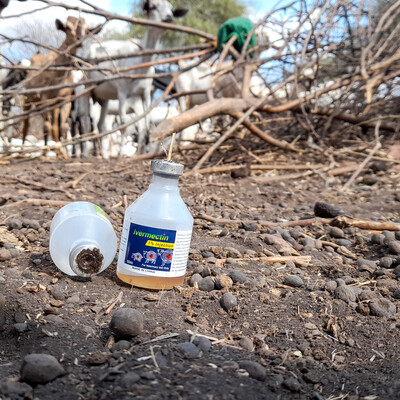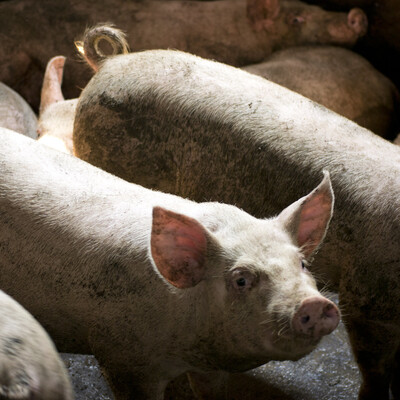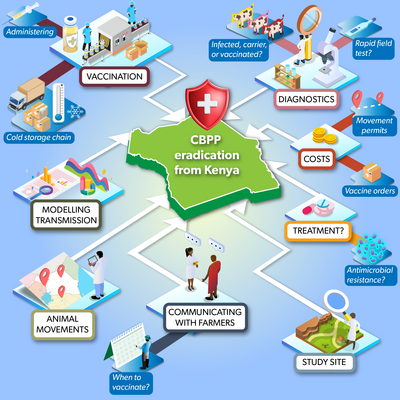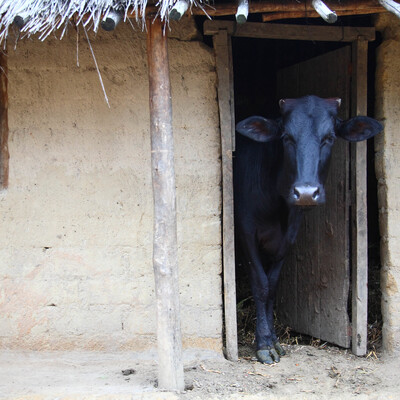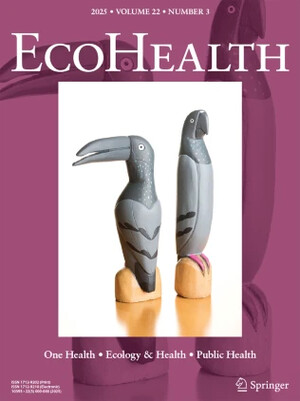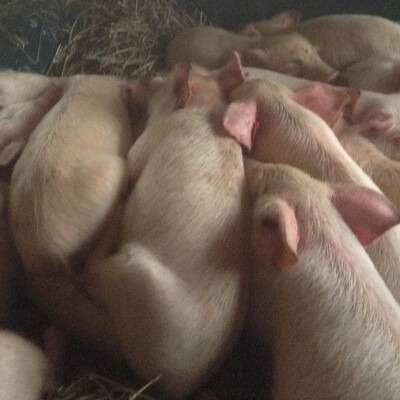
New research offers glimpse into the future of livestock-derived foods
A pork butcher in Uganda (photo credit: ILRI)
How will the demand for livestock-derived foods (LDFs), i.e., meat, milk and eggs, evolve over the coming decades? What will these changes in demand mean for the future of LDF production and international trade? And what implications will all this have for human and environmental health? Dolapo Enahoro, an agricultural economist with ILRI’s Policies, Institutions and Livelihoods Program, and Adam Komarek, a senior lecturer in the School of Agriculture and Food Sciences at the University of Queensland, provide new perspectives on these questions in two related papers. Dolapo has spent her career focusing on the economic evaluation of technology, investment and policy options for improving livestock productivity and its impacts on food security, livelihoods and the environment. She has more than ten years of experience building and applying tools of foresight analysis in developing country contexts. Adam, who previously worked for IFPRI, has 12 years of post-PhD work experience studying the economics of sustainable agriculture, risk and resilience, rural livelihoods, interactions between the environment and agricultural systems, and food supply chains. Dolapo and Adam recently spoke with ILRI Princeton in Africa Fellow Elliot Carleton to discuss what their recent papers, one of which they co-authored, reveal about the future of LDFs.
Elliot: Let me start by congratulating you both on your recent work! There are some really illuminating findings in both of these papers. Unfortunately, they also reminded me how much of my economics degree I have already forgotten. So, bear with me as I ask some questions that will hopefully allow us to explore your recent findings.
But before we jump into your new research, I want to start with a more introductory question. Both papers mention that there has been a recent increase in the global demand for LDFs. Can you explain a little more about what exactly is driving that demand growth?
Dolapo: Much of the growth in demand for LDFs has been in developing regions where it is fueled by factors such as higher incomes, globalization, urbanization and the dietary changes these bring. But in addition to all those complex factors, demand has also grown due to increased populations, which is primarily the case in Africa.
Adam: And preferences are also a vital factor in demand. Preferences are non-price and non-income factors that influence demand, such as consumer attitudes towards the health and environmental implications of LDFs, attitudes towards food safety, the visual appearance of food, such as red meat marbling, the convenience of food preparation and animal welfare concerns, among others. But these preferences change as incomes change. Essentially, changes in preferences and income play an important role in understanding demand for LDFs, although these preferences can vary substantially in different parts of the world.
Elliot: OK, so that all makes sense, but then again, all those findings are based on the concrete events of recent years. It is much harder for me to imagine how we could obtain projections about the future demand for LDFs, especially given the variety of factors influencing demand. Yet, these two papers make projections all the way to 2050. So, how exactly did you go about predicting the future?
Dolapo: OK, so the models in these papers do not provide predictions per se but allow for a range of ‘what-if’ scenarios based on changes in the underlying drivers of the global agricultural system, such as population growth, incomes, technological change and climate. So we use a ‘business-as-usual’ scenario in which we assume that population, income and technological change in the agricultural and livestock sector will continue, in this case to 2050, to grow at the same pace as observed historically.
Elliot: Those seem like strong assumptions to make.
Dolapo: These are strong assumptions, but they provide a reasonable baseline against which we can compare how deviations in the underlying factors will impact the global agricultural system. This then gives us a framework for analyzing the potential impacts of changes in the factors driving the system, including those initiated by deliberate intervention, such as livestock sector policy.
Adam: Essentially, we take a look at deep uncertainty. It may sound like a bit of an evasion of your question, but we prefer to focus on the implications of alternative future scenarios. This can help us to think as decision-makers about how we can be prepared for each pathway. We do not try to predict the future but rather provide analysis to allow us to prepare for the future. This is all is within the realm of foresight analysis, which has a long tradition of use in the CGIAR.
Elliot: So, these models are not so much time machines as they are planning tools?
Adam: Right.
Elliot: OK, great. That is really helpful for understanding the broader significance of your research.
With some of the more technical components out of the way, we can start to jump into your main findings.
So, Dolapo, based on the models in your OIE paper ‘Current and future trade in livestock products’, what sort of scenarios can we expect to see in the international trade of LDFs by 2050?
Dolapo: Barring any major changes in the key drivers of the global agricultural system, we see a situation where the demand for LDFs in many low- and middle-income countries (LMICs) outpaces production within these countries. This means that more countries import LDFs and they import greater quantities. We even see projections of increased net imports in some developed countries, such as beef imports in the USA.
Elliot: But of course, those rising imports must be met by rising exports elsewhere in the world.
Dolapo: Right. Overall, meat exports become more consolidated and imports more dispersed, with more countries moving to net importer positions than previously was the case. Meat exports in 2050 are projected to originate mostly in developed countries and in South America, while imports are consolidated in Asia and to a lesser extent, Africa. On a product-by-region basis, poultry and pork exports are highest in northern, central and southern America. Imports are highest in China and Russia, but also expand, albeit to a lesser extent, in Africa. Beef exports come mainly from central and southern America, while countries in Asia, plus the United States, are the main net importer destinations. Small ruminant meat presents the unique case where meat export does not consolidate, in that we see more, not fewer, net exporting countries for sheep and goat meat across central and North America, Europe, Asia and Africa. As a region, however, Africa goes from net exporter to net importer. China is expected to become the major net importing country for sheep and goat meat globally in 2050.
Elliot: It is interesting that imports and exports follow such different trends in terms of consolidation. And all this talk about imports and exports brings me to another question you explored in this paper, which is what this increase in trade could mean for the future of animal diseases. Could you explain your findings on that topic?
Dolapo: Sure. So as the demand for LDFs grows, mainly in developing regions, we can anticipate the increased movement of livestock products and animals across borders. Such movement comes with a higher risk of the spread of transboundary animal diseases, including zoonotic diseases that transmit between humans and animals. This is particularly the case where border controls and health surveillance systems are weak. In Africa, the spread between countries of highly contagious animal diseases such as foot and mouth disease (FMD), Peste des petits ruminants, and Rift Valley fever, as well as of diseases such as African swine fever associated with trade in meat products, has had serious public health and socio-economic consequences. These diseases also pose significant barriers to international trade, with for example, certain countries only willing to accept beef imports from countries or zones designated as being FMD-free.
Elliot: I find the increased potential for zoonotic diseases particularly alarming given the world’s continuing struggles with the COVID-19 pandemic. Is there any way to counteract some of these cross-border animal diseases?
Dolapo: So, our projections of much higher international trade in livestock food products in 2050 indicate a changing role for veterinary services globally. The mobility of livestock and livestock products will need to be better managed alongside increased threats to animal health and food safety in LMICs where the demand for livestock food products is growing rapidly.
Elliot: And just to clarify, what exactly do you mean by ‘better managed’?
Dolapo: That would include an expanded role of veterinary services departments in low-income countries (LICs) that support local producers, the design and implementation of risk-based approaches to disease management along the food chain, improved legislation and regulation, monitoring and surveillance and international cooperation to uphold standards.
Elliot: This seems like a great example of the preparative implications of your work: it sounds like we should start preparing now for the greater risk of animal and zoonotic diseases in the future.
Dolapo: Definitely.
Elliot: And that is a really valuable finding.
OK, so now I want to shift to the Global Environmental Change paper which you led, Adam, titled ‘Income, consumer preferences and the future of livestock-derived food demand’. That paper examines future demand for LDFs rather than trade. Earlier we talked about how the demand for meat has been increasing recently—is it foolish to expect that trend to simply continue in the future?
Adam: It is a little more complex than that, as there is nothing to say the past will repeat itself, but at the same time the future is not a blank canvas. In fact, per person demand for red meat will most likely decline in high-income countries (HICs), and historical data is already showing that this is happening in parts of the EU and North America. But since total demand is a combination of per person demand and population, even if per person demand is falling, total demand may still be increasing if the population is increasing.
Elliot: OK, so it is certainly more complex than a simple continuation of current trends. There are a lot of different factors at work here.
I’m interested in the point you make about the per person demand for red meat falling in some parts of the EU and North America. Can you explain what is causing that?
Adam: Well, this goes back to what we talked about earlier related to consumer preferences. Changing consumer preferences in HICs based mainly on concerns over the environmental and health effects of LDFs, along with animal welfare concerns, may be leading to this decline in per person red meat demand. Although this is partly my speculation, and survey data at the individual person level would really be needed to identify why diets are shifting, but we have definitely seen in national-scale statistics a plateauing and even decline in per person demand for red meat in HICs, and changing consumer preferences are no doubt part of the story.
Elliot: But this is only happening in HICs, correct? So, could we potentially see opposing trends in different parts of the world?
Adam: Yes, exactly. Essentially, we are seeing two major trends coming from opposite directions: income growth in LMICs and social and environmental concerns plus a nutrition transition away from meat in HICs, like a westerly wind and easterly wind blowing into each other.
Elliot: It seems like those competing effects would make it even more challenging to make projections about the future.
Adam: Certainly, but there are still some things we can observe. For example, in contrast to some HICs, in LMICs we have observed demand growth for livestock products, and we expect this to continue through 2050 based on things like rising income.
Dolapo: Overall, our models project that average protein demand for meat, including beef, sheep, goat, poultry and pork, across the globe will increase by 16 per cent per person and 39 per cent in total between the year 2020 and the year 2050 if trends in income and population continue along a mid-range trajectory. The fastest per person rates of projected increase were 44 per cent in Africa and 47 per cent in South America.
Elliot: You mention those projections are based on current trends in things like income and population. How do some of those other factors that you mentioned earlier which also influence demand play into this?
Adam: There are a number of wild cards that could throw a spanner in demand projections, such as the role of any new climate policies that, for example, impose limitations on greenhouse gas emissions from livestock, or the introduction of in-vitro meat like the meatless burger. The issue of ‘social license’ is also very important, especially the environmental and social dimensions of red meat.
Elliot: And by social license, do you mean the extent to which society approves of LDFs—both ethically and environmentally?
Adam: Right. Seeing how this translates into changes in actual demand will be interesting to observe, but it can be hard to quantify in a modelling sense. I think this is a very interesting topic moving forward as consumption demand for livestock production has massive implications for the natural environment, human health, and livelihoods.
Elliot: I’m glad you brought up some of the important implications of this research. Given the significance of these papers in allowing us to better prepare for the future, I am wondering what implications you see for the future of human and environmental health.
Adam: It highlights both looming challenges and opportunities. Essentially, there are potential consequences of rising demand for diets and health, the environment and also the livelihoods of producers. For example, investment and policy targets to achieve carbon-neutral beef production or feed additives to reduce methane emissions. Human health as it relates to livestock is complex, as there is a double burden of malnutrition—there could be a golden mean of not too much and not too little. It is very dependent on context, where people live, their income, their preferences, their options, their current health, their society etc. The connection between human diets and sustainability is a major topic going forward, as we see with the EAT Lancet Commission and UN Food Systems Summit. Livelihoods will be another important topic going forward, both for pastoralists and farmers.
Dolapo: And to add on to that, our research highlights the key role of international trade in that ongoing discussion about the links of livestock to diets, human health, livelihoods and the environment. Higher demand for LDFs in LMICs will not necessarily be met by domestic production, with its livelihood implications, given the historical performance of production and marketing systems. There are then trade-offs to consider between global access to LDFs and improved diets, consumer prices and producer incomes and the environmental impacts of both domestic production and long supply chains for LDFs. One additional thing to note is that better data is needed to correctly interpret or anticipate the trends and trade-offs related to international trade in LDFs.
Elliot: You both bring up the potential implications of this research for global livelihoods. I’m wondering what will happen to all those across the developing world who rely on the production of LDFs for their income if the increased availability of LDFs were to drive down prices?
Adam: So that is a bit of a complex question. The revenue part of income is a function of price and quantity, so the question is whether the positive effect of an increase in the quantity produced offsets the negative effect of a price decline. Typically, we would see people adjust to lower prices by shifting their resources to other income-generating activities. But sometimes the alternative options are limited, and this is often the case for pastoralists. So, this is certainly a concern and something we will need to monitor going forward.
Elliot: It sounds like the future of LDFs could bring a variety of positives and negatives for both people and the environment. But these two recent papers can help us prepare for that future, so we can work to enhance the positives of LDF growth and minimize the negatives.
Related Stories
Scaling up One Health in the livestock sector
Guardian op-ed makes case that criticism of animal farming risks health of world's poorest






